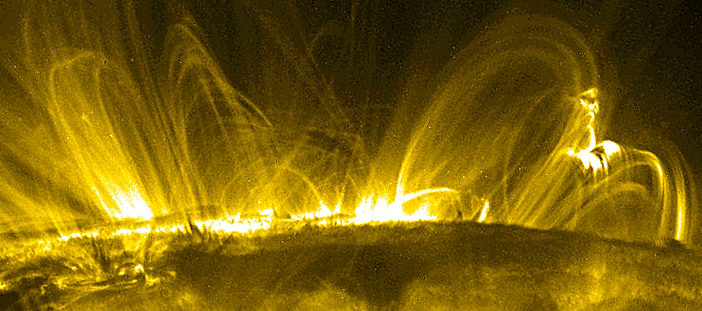Editor’s note: Astrobites is a graduate-student-run organization that digests astrophysical literature for undergraduate students. As part of the partnership between the AAS and astrobites, we occasionally repost astrobites content here at AAS Nova. We hope you enjoy this post from astrobites; the original can be viewed at astrobites.org.
Title: New Evidence that Magnetoconvection Drives Solar-Stellar Coronal Heating
Author: Sanjiv K. Tiwari, Julia K. Thalmann, Navdeep K. Panesar, Ronald L. Moore, Amy R. Winebarger
First Author’s Institution: Lockheed Martin Solar and Astrophysics Laboratory; Bay Area Environmental Research Institute
Status: Published in ApJL
The coronal heating problem is one of the biggest unsolved mysteries in solar physics. The solar corona is the region of the Sun’s atmosphere that extends past the surface — or photosphere — of the Sun. It is a diffuse cloud of plasma that is heated to temperatures several hundred times that of the photosphere, which isn’t what you’d expect as you move further away from a hot object. The coronal heating problem has been hotly debated since the 1940s and is thought to be related to the Sun’s magnetic field. However, no theory has yet been able to explain why the corona is so much hotter than the photosphere, and the possibility remains that multiple processes may be at work.

Figure 1. Image of a sunspot showing the umbra and penumbra region. [SpaceWeatherLive]
Using data from the Solar Dynamics Observatory (SDO), the authors selected two regions with both sunspots and coronal loops, known as active regions. Although we can see coronal plasma trace magnetic field lines in coronal loops, there is still no way to directly measure the coronal magnetic field. The authors used simulations to reconstruct and determine the strength of the coronal magnetic field based on the magnetic field at the base of the loops (which can be directly measured using instruments like SDO). One of the example active regions, along with its simulated coronal magnetic field, is shown in Figure 2.

Figure 2. Image of one example active region (NOAA 12108) plotted with the simulated coronal magnetic field. The line color indicates the height of the magnetic field line above the surface of the Sun. [Tiwari et al. 2017]

Figure 3. Schematic drawing of an active region showing the dependence of coronal loop brightness on footpoint location. Brighter colors indicate brighter emission in SDO images. [Tiwari et al. 2017]
Through observations and simulations of two active regions, today’s paper shows that both convection and a strong magnetic field in the footprints of coronal loops are necessary for heating to occur. This provides yet another clue to solving the decades-old coronal heating problem. With several new instruments like the ground-based solar telescope, DKIST, and the Parker Solar Probe coming online soon, this mystery may be solved sooner than you think.
About the author, Ellis Avallone:
I am a first-year graduate student at the University of Hawaii at Manoa Institute for Astronomy, where I study the Sun. My current research focuses on how the solar magnetic field triggers eruptions that can affect us here on Earth. In my free time I enjoy rock climbing, painting, and eating copious amounts of mac and cheese.
